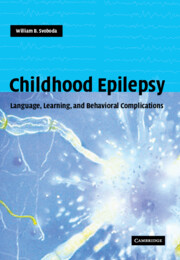Book contents
- Frontmatter
- Contents
- Preface
- Glossary
- 1 Looking ahead
- Part I Speech and language problems
- Part II Learning problems
- Part III Behavior problems
- 27 Mental health needs
- 28 Psychologic development
- 29 Seizure types and modifying factors
- 30 Overview: extrinsic factors
- 31 Behavior problems: general
- 32 Attention deficit disorders
- 33 Anxiety disorders
- 34 Mood disorders
- 35 Disruptive behavior problems
- 36 Psychoses of epilepsy
- 37 Non-epileptic events
- 38 Possible treatment issues
- 39 Helping with psychiatric problems
- 40 Epilog
- Index
- References
37 - Non-epileptic events
from Part III - Behavior problems
Published online by Cambridge University Press: 26 October 2009
- Frontmatter
- Contents
- Preface
- Glossary
- 1 Looking ahead
- Part I Speech and language problems
- Part II Learning problems
- Part III Behavior problems
- 27 Mental health needs
- 28 Psychologic development
- 29 Seizure types and modifying factors
- 30 Overview: extrinsic factors
- 31 Behavior problems: general
- 32 Attention deficit disorders
- 33 Anxiety disorders
- 34 Mood disorders
- 35 Disruptive behavior problems
- 36 Psychoses of epilepsy
- 37 Non-epileptic events
- 38 Possible treatment issues
- 39 Helping with psychiatric problems
- 40 Epilog
- Index
- References
Summary
About 18% of children, including adolescents, with new seizures are found to have pseudoseizures (Golden et al., 1985; Pakalnis et al., 1999; Lancman et al., 2002; Lelliott & Fenwick, 1999). These events have been called non-epileptic events or episodes, non-epileptic seizures, pseudoseizures, hysterical seizures, conversion convulsions, and “fake” seizures (Gross, 1983; Gumnit & Gates, 1986; Riley & Roy, 1982; Trimble, 1981).
In conversion reactions, adults often present with a loss of function, whereas children tend to present with pain, pseudoseizures, or syncope. In children, the incidence of a conversion reaction is at least 1–2% and perhaps as high as 5% (Robins & O'Neal, 1953; Hersov, 1985; Hinman, 1958; Goodyer, 1981). Such reactions occur three times more often in adolescents than in younger children. Children often present with anxiety and psychological problems, whereas adults may present with a “la belle indifference” affect (Dubowitz & Hersov, 1976; Malony, 1980; Goodyer, 1981).
Non-epileptic seizures are one of the most common conversion symptoms in childhood. They appear in children with and without epileptic seizures. They may involve subconscious reactions to a past or present stress, or the intentional production of symptoms either to achieve a goal (Mills & Lipian, 1997; Weisbrot & Ettinger, 1998). When a child experiences both epilepsy and non-epileptic events, the parents may find the decision to seek mental health help difficult, especially if there is a history of brain injury.
Definition
Non-epileptic seizures are clinical events that resemble epileptic attacks but are not associated with physiologic CNS changes.
- Type
- Chapter
- Information
- Childhood EpilepsyLanguage, Learning and Behavioural Complications, pp. 566 - 589Publisher: Cambridge University PressPrint publication year: 2004



